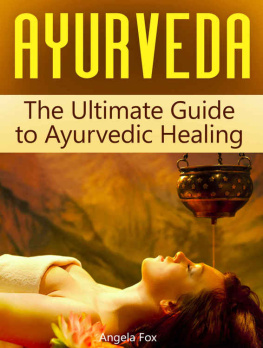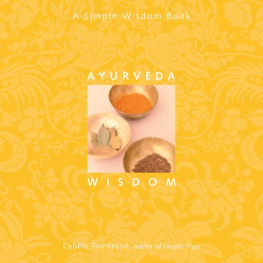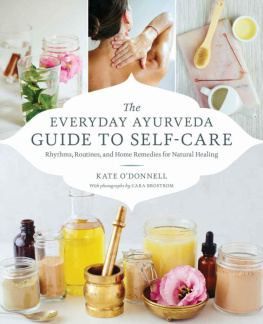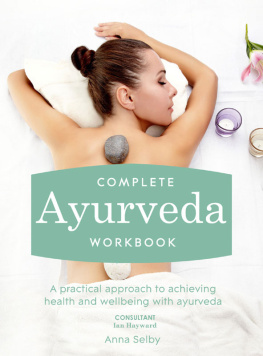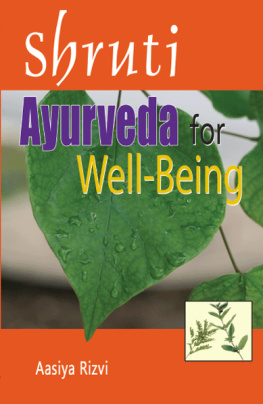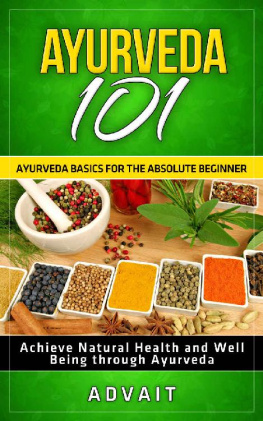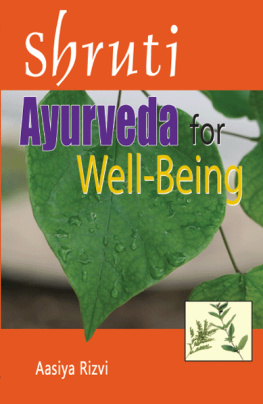AYURVEDA
The Ultimate Guide to Ayurvedic Healing
TABLE OF CONTENTS
Copyright Notice
Copyright 2016 by Angela Fox - All rights reserved.
This document is geared towards providing exact and reliable information in regards to the topic and issue covered. The publication is sold with the idea that the publisher is not required to render accounting, officially permitted, or otherwise, qualified services. If advice is necessary, legal or professional, a practiced individual in the profession should be ordered.
- From a Declaration of Principles which was accepted and approved equally by a Committee of the American Bar Association and a Committee of Publishers and Associations.
In no way is it legal to reproduce, duplicate, or transmit any part of this document in either electronic means or in printed format. Recording of this publication is strictly prohibited and any storage of this document is not allowed unless with written permission from the publisher. All rights reserved.
The information provided herein is stated to be truthful and consistent, in that any liability, in terms of inattention or otherwise, by any usage or abuse of any policies, processes, or directions contained within is the solitary and utter responsibility of the recipient reader. Under no circumstances will any legal responsibility or blame be held against the publisher for any reparation, damages, or monetary loss due to the information herein, either directly or indirectly.
Respective authors own all copyrights not held by the publisher.
The information herein is offered for informational purposes solely, and is universal as so. The presentation of the information is without contract or any type of guarantee assurance.
The trademarks that are used are without any consent, and the publication of the trademark is without permission or backing by the trademark owner. All trademarks and brands within this book are for clarifying purposes only and are the owned by the owners themselves, not affiliated with this document.
Disclaimer
While all attempts have been made to verify the information provided in this book, the author does not assume any responsibility for errors, omissions, or contrary interpretations of the subject matter contained within. The information provided in this book is for educational and entertainment purposes only. The reader is responsible for his or her own actions and the author does not accept any responsibilities for any liabilities or damages, real or perceived, resulting from the use of this information.
INTRODUCTION
There are so many health and diet fads out there it can be difficult to know what works and what is just the latest trend out there. Ayurveda has been around for thousands of years, and there have been no negative reports or studies that show its not good for you. In fact, research studies have shown that there are aspects of Ayurveda that can be incredibly beneficial for your health, and it is recommended by some physicians to be practiced alongside Western medicine.

Ayurveda
Ayurveda combines all those properties of nature that we have heard so much about spices, herbs, aromatherapy, massage and diet. But it is the concept of taking care of your digestive system that is the foundation behind the theories of Ayurveda. If you take care of your digestion, you are taking care of the rest of your body.
Unlike the multitude of diets out there, Ayurveda is not a diet, it just involves changing what you eat and how, based on your predominant dosha. Each person has a predominant dosha as well as the other two doshas. The three are Vata, Pitta and Kapha, and if any of them become imbalanced, health problems arise. Ayurveda is about working with natural ingredients to keep these doshas balanced and therefore preventing illness and disease.
Dont fret that you have to come up with complicated menu plans or scour the earth for rare and expensive ingredients. None of that is necessary; you simply need to change the foods you eat to those that are natural, organic and fresh. How easy is that? There are different foods suitable for each dosha, so its important to learn what your predominant one is. After that, its all so incredibly easy you wont believe it!
Busy days mean upset digestion, so the use of Ayurveda herbal blends, aromatherapy and massage can help you destress at the end of the day and prepare your mind and body for sleep. When you get a good nights sleep, your body has the time to naturally repair itself, so its essential to head off to bed early and get up early. This may seem impossible at first, but once you get used to it, you will understand why its so important.
You will find all sorts of information and tips about Ayurveda in this book about the types of doshas, dietary requirements for doshas, how to keep them balanced and the effects the herbal supplements have on your body and mind. Youll even learn how to take care of your feet! Feet are so important yet we tend to forget about them! There is so much you can learn with Ayurveda, and at the end of the book you will find a list of the top twenty tips to help you bring Ayurveda into your life.
CHAPTER 1 AYURVEDA AS A COMPLEMENTARY SYSTEM OF HEALING
It is important to know and understand what the difference is between Western medicine and Ayurveda. With Western medicine, the primary focus is on symptoms and disease, and the main forms of treatment are typically pharmaceutical medicines and surgical procedures. This is absolutely necessary, and the purpose of Ayurveda is not to remove Western medicine and practices, but to enhance it.
Ayurveda focuses on maintaining a balance in energy as a means of supporting life. If the flow of energy is balanced, and the stress levels are low, the body is better able to fight off illness with its natural defense systems. When practiced in conjunction with Western medicine, the body is strengthened and less likely to develop diseases, and it will also help to rebuild the body following surgical procedures or drug therapy.
Often we feel unwell, but there is no apparent illness or disease. This is because the body has become unbalanced, and has not yet progressed to illness. It is at this time that Ayurveda can help to recreate balance in the body, consciousness and mind.
Evaluating Imbalances
Health and balance are assessed using a variety of Ayurveda techniques. A practitioner of Ayurveda will normally take the pulse, look at the body, eyes and tongue. They may also listen to the sound of your voice, as tone can give clues to imbalances. The practitioner will ask questions, and looks for any physical signs or symptoms of illness. This will help them determine what is imbalanced and how to best recreate balance.
Some treatments may include changing diet, using herbs and aromatherapy, and in some cases, undergoing an internal detoxification. The cleansing program, panchakarma, helps the body get rid of any toxins that have accumulated, and by doing this, more benefits can be gained from other forms of treatment.
Concepts of Ayurveda

Ayurveda concepts
Ayurvedic theory believes that every living or non-living thing throughout the universe is connected in some way. It is believed that to achieve good health, your body, mind and spirit need to be in harmony with the universe. When this connection is disrupted, sickness and poor health occur. Some forms of disruption include:

